Appendix 1: Foundation Programs aims and progress for 2016

1. DEEP-EARTH FLUIDS IN COLLISION ZONES AND CRATONIC ROOTS (TARDIS II)
Themes 1, 2 and 3, Early Earth, Earth's Evolution and Earth Today, contributing to understanding Earth's Architecture and Fluid Fluxes.
AIMS
This program investigates the role of fluids in the deep mantle and lithosphere, using studies of kimberlites and other volcanic rocks, xenoliths of mantle and crustal rocks in volcanic rocks, ophiolites, and ultra-high pressure terrains related to subduction zones. Super-reducing, ultra-high pressure (SuR-UHP: 400-600 km) mineral assemblages in some ophiolites carry implications for the evolution of fluid compositions, reactions and redox states in subduction environments from the surface to the Transition Zone, and suggest a newly recognised geodynamic collision process that may improve mineral exploration concepts for paleosubduction regimes. The recent discovery of similar exceptionally reduced mineral assemblages in ejecta from Cretaceous volcanoes in Israel suggests a previously unrecognised process of interaction between deep mantle fluids and ascending basaltic magmas. We aim to produce an experimentally testable model for the generation of such fluids in the mantle, to quantify constraints on the geochemical and tectonic processes that produce SuR-UHP assemblages, and to formulate a geodynamic model for their formation.
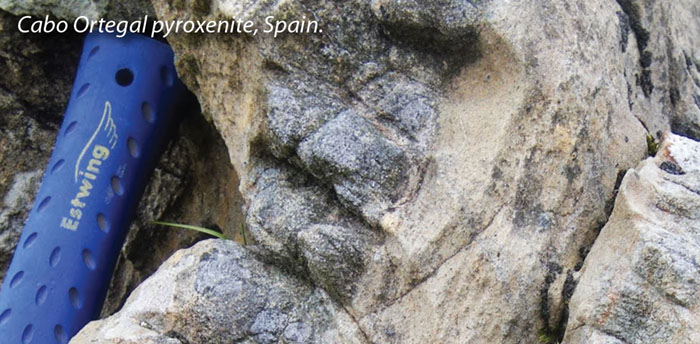
2016 REPORT
A comprehensive investigation of microstructures and mineralogy in Tibetan ophiolites has defined their evolution, including formation in ancient SCLM within a subduction zone setting, followed by transport into the upper transition zone, exhumation to the sea floor and finally emplacement by thrusting during continental collision. The Zedang ophiolite had a two-stage history, with the deeply subducted harzburgite portion being underplated by a younger lherzolitic portion before both were emplaced onto the continental crust. This model is now being tested for other ophiolitic bodies along the Yarlong-Zangbo suture. On the north side of this suture, studies of ultrapotassic rocks and mantle xenoliths are shedding new light on the lithospheric structure of the Lhasa block, and its control on Cu-porphyry mineralisation. The team was joined by Dr Hadi Shafaii Moghadam, who is investigating the Iranian section of the Tethyan Belt, integrating field studies, petrology and isotopic geochemistry of granitoid rocks (as probes of the deep crust), volcanic rocks and ophiolites. The evolution of this ‘soft collision zone’ can then be compared and contrasted with the ‘hard collision’ between India and Asia as exposed in Tibet. The project has already established a geochemical and geochronological framework, and shown the existence of buried Archean-Paleoproterozoic crust. Studies of the suite of highly reduced minerals in the ejecta from Cretaceous volcanoes in Israel (industrial collaboration with Shefa Yamim Ltd., Akko) led to the development of a model involving interaction of mantle-derived methane and hydrogen with basaltic magmas in conduits near the crust-mantle boundary. Detailed mineralogical studies included TEM analysis, in collaboration with Professor Martin Saunders (CMCA, UWA) and FE-SEM work with Professor V. Kamenetsky (UTAS). SIMS analyses of Si and C isotopes (Perth and Beijing) identified two suites of moissanite in the alluvial deposits and volcanic rocks, suggesting the presence of younger eruptions carrying similarly reduced xenolithic material. Analysis of zircons from the different Cretaceous volcanic bodies revealed an unexpectedly long history of magmatism in the mantle beneath Mount Carmel, extending back to the Permian. Work on other mantle rocks continued, including Victorian and Cabo Ortegal pyroxenites, Au in pyroxenites, the lithosphere beneath the Pannonian Basin (Hungary-Slovakia). Studies of kimberlites and diamonds in Angola, Siberia and South Africa, included conventional (S, C, O, N) and unconventional (Mg, Fe) isotopes. Work on the deep crust and its reworking continued in China, with petrological studies of xenoliths and adakites, and magnetotelluric imaging of the Dabie UHP terrain. Mathieu Chasse’s study of Sc speciation in NSW laterites (industry collaboration, Jervois Mining Ltd.) produced exciting results relevant to the exploitation of this important resource.
See Research highlights Genesis of deposits of scandium, a promising rare metal, Strange mineral companions, Magmatism lights up northern Gondwana 500-600 million years ago, Mineral gymnastics track subduction zone processes, Volcanic debris from up to 60 km beneath western Victoria tracks tectonic ups and downs, Birdshot on Mt Carmel: Immiscible metal, metal-oxide and silicate melts, Use and misuse of ilmenite in diamond exploration.
Published outputs for 2016
CCFS publications: #793, 797, 799, 801, 805, 812, 816, 821, 822, 825, 826, 827, 828, 830, 831, 833, 834, 835, 841, 851, 856, 858, 862, 863, 864, 865, 867, 876, 878, 881, 924
27 Conference Abstracts

2. GENESIS, TRANSFER AND FOCUS OF FLUIDS AND METALS
Themes 2 and 3, Earth’s Evolution and Earth Today, contributing to understanding Earth’s Fluid Fluxes.
AIMS
This program embodies a holistic approach to ore deposit research, acknowledging that the genesis of mineral occurrences requires the conjunction in time and space of three main independent parameters: fertility, lithosphere-scale architecture, and favourable transient geodynamics. In this context, the integrated studies in this Flagship program address the critical link between metal source fertility and four-dimensional evolution of multi-scale fluid pathways that ensure efficient mass and fluid flux transfer between the mantle and the upper crust. Our studies test the hypothesis that the genesis of sizeable mineral deposits is the end product of self-organised critical systems operating from the scale of the planet all the way to the very focused environment where ore deposits can form. This Flagship Program is not commodity-focused but rather looks at the basic commonalities among various mineral systems to unravel the main constraints in the formation of ore systems.
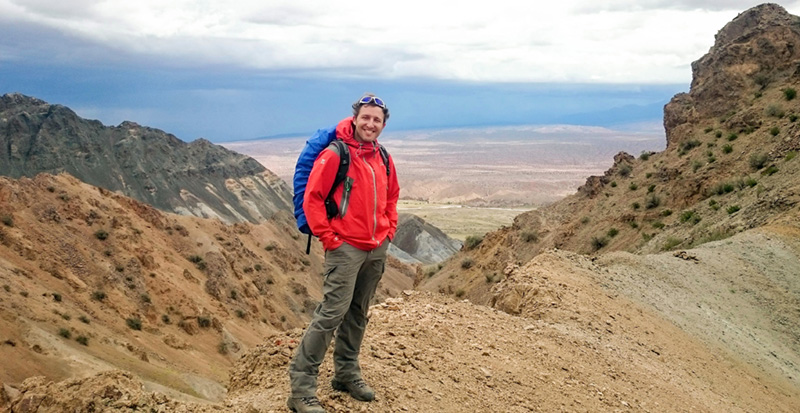
Marco Fiorentini hiking through the Cu-Mo prospect ‘Alcaparossa’ in the province of San Juan, Argentina, as a large storm drifts across the Cordillera Frontal (photo by Greg Poole).
2016 REPORT
In 2016, the ongoing integrated projects reached some important milestones. Projects in Module 1 (Fertility) focused on unravelling the global cycle of metals. Outcomes include the definition of a new calibrated oxybarometer that may be indirectly applied to discriminate the copper fertility of porphyry belts as well as unravel the secular oxygen fugacity evolution of the planet from the Hadean through the Eoarchean (see Research highlights Zircon trace elements reveal oxidation signatures in ancient mantle and Cerium in zircon - serial tracking of mantle controls), as well as the definition of new fertility indicators for porphyry copper mineralisation based on the trace element composition of zircon (see Research highlights Isotopic canaries in zircon track Cu prospectivity across Southern Tibet and Zircon - a pathfinder for porphyry Cu ± Mo ± Au deposits). This work is integrated with ongoing porphyry studies to develop a new metallogenic model for porphyry-related and epithermal systems of the Permian-Triassic Choiyoi Group in the Cordillera Frontal, Argentina (PhD study by Greg Poole) and in the Macquarie Arc of New South Wales (postdoc project by Johannes Hammerli). Finally, recent work completed in east Greenland suggests that nickel sulfide mineralisation associated with the Ammassalik Intrusive Complex may be genetically related to the highly endowed ca. 1.9 Ga Kotalhati belt in the Svecofennian Province of Scandinavia, thus opening up the prospectivity of that region for Ni-Cu intrusion-hosted deposits (see Research highlight Is the Ammassalik Intrusive Complex (South East Greenland) part of an ancient Ni-Cu magmatic province?).
Projects in Module 2 (Architecture) have made significant progress in defining and imaging the key pathways that connect geochemical reservoirs, permitting the efficient multi-scale flux of energy and fluids in space and time. The PhD work of Linda Iaccheri on the North Australian Craton was successfully completed, whereas the PhD studies of Katarina Bjorkman and Eunjoo Choi, in the Superior and Yilgarn cratons, respectively, have reached significant milestones. Within Module 2, the high-precision TIMS work carried out by Jack Stirling (Masters’ project) focused on the Kohistan Arc Complex of northeast Pakistan, providing a refinement of current models describing continental crust formation in island arc settings, with crucial implications for the understanding of the architecture of magma plumbing networks in the lower crust. Finally, in Module 3 (Transient Geodynamics), the seminal work of Chris Gonzalez coupled, for the first time, geodynamic modelling with the solidi for carbonated basalts and sediments at pressures and temperatures relevant to upper mantle conditions. This was accomplished by a robust thermomechanical and petrological modelling framework previously applied to decarbonation of subducting slabs and in intracratonic settings.
See Research highlights Apatite - tracer for the evolution of porphyry systems, Isotopic canaries in zircon track Cu prospectivity across Southern Tibet Is the Ammassalik Intrusive Complex (South East Greenland) part of an ancient Ni-Cu magmatic province?, Zircon - a pathfinder for porphyry Cu ± Mo ± Au deposits, Sulfur-loving elements in meteorites from Mars probe the extra-terrestrial mantle?, Cerium in zircon - serial tracking of mantle controls, Zircon trace elements reveal oxidation signatures in ancient mantle.
Published outputs for 2016
CCFS Publications: #630, 639, 644, 646, 657, 660, 686, 682, 797, 811, 813, 846, 847, 873, 879
> 25 Conference Abstracts

3. MODELLING FLUID AND MELT FLOW IN MANTLE AND CRUST
Themes 2 and 3, Earth’s Evolution and Earth Today, contributing to understanding Earth’s Architecture and Fluid Fluxes.
AIMS
Many aspects of Earth Science, from ore deposits to giant earthquakes, depend critically on the complex interaction of solids and fluids. Numerical simulation of these processes and effective visualisations of the results is critical to understanding how these Earth system components work, but our ability to do this is currently very limited. Flagship Program 3 is developing the next generation of numerical codes and aims to refine the thermodynamic parameters involved by integrating high- pressure experiments to handle these complex problems. This will lead to important improvements in the quantification and visualisation of Earth processes, and will be applied to a variety of geodynamic situations.
The new high-pressure experimental group at Macquarie joins this initiative to provide input on physico-chemical parameters of minerals, melts and fluids in the deep mantle, the composition of melts that infiltrate the lithosphere, and their effects on its geodynamics and stability.
The evolution of Hadean Earth - Response of the early Earth to an extreme (1700 km radius) impact event. The large impact drives wholesale recycling of the proto-lithosphere.
2016 REPORT
In 2016, several features of our modified version of the code ASPECT, which has been in development over the past few years, have been improved. We revised the impact heating formulation in our model, and have applied it to the Hadean Earth to study how the Late Heavy Bombardment affects mantle and core evolution (see below). We also improved our melting treatment, which now takes into account vertical advection of heat/material during melt extraction and emplacement (known as the ‘Heat Pipe’ model). This effect is crucial in early planetary body evolution and has not been treated in detail in previous global-scale models. Based on these developments, we are developing early lunar models to study the link between post- magma-ocean overturn and lunar crustal evolution.
A main aim of this program is the development of in-house computational simulation tools to model complex geochemical- geodynamic processes involving multiple-phase reactive flow in multi-component deformable media (MCMPRF). The mathematical formulation and computational implementation was copmpleted and benchmarked at the end of 2016 (Oliveira et al. 2016; 2017). This new MCMPRF approach is now being applied to study the evolution of trace-elements during melt generation, percolation and extraction in MOR environments and in 2017 we plan to apply it to study mantle metasomatism beneath continents as well as incorporate it into the ASPECT models developed in the global stream.
This year, we developed a method of joint tomography of body wave and surface wave, which enables us to image fine structures from the surface down to the transition zone. We applied this method to NE China to build a high-resolution crustal and upper mantle model by joint inversion of body wave travel- time and surface wave dispersion curves. The joint tomography significantly improves the resolution at shallow depths compared with the body-wave tomography, and provides seismic evidence for the origin and dynamics of Quaternary intraplate volcanoes in NE China. The new model supports the idea that mantle upwelling beneath the Changbaishan volcano originates from the mantle transition zone. The lithosphere beneath this region has been thinned to ~60 km, as revealed by the joint inversion model. Our model illustrates localised mantle upwelling beneath the Abaga and Halaha volcanoes in the Xinmeng belt, which is not directly related to the deep subduction of the Pacific slab, but more likely due to the mantle convection at shallow depths (see Research highlights Does the mantle move beneath Northeast China?.
Plans for the expansion to the high-pressure laboratory have been delayed due to the extension of the building plans to include the whole basement area of the building in which the experimental laboratory is located. A new laser-diamond anvil cell is under construction and should be ready for use in mid-2017, and an additional piston-cylinder apparatus will be acquired shortly. Experiments on electrical conductivity in mantle materials have been written up and submitted for publication, and projects on the role of blueschists in the production of volcanic melts in collisional areas (see Research highlights) and on the role of deep carbon under the continents are advanced.
See Research highlights Does the mantle move beneath Northeast China?, Potassium-rich magmas from a phlogopite-free source.
Published outputs for 2016
CCFS Publications: #578, 656, 668, 675, 685, 706
13 Conference Abstracts

4. ATMOSPHERIC, ENVIRONMENTAL AND BIOLOGICAL EVOLUTION
Theme 1 Early Earth, contributing to understanding Earth’s Architecture and Fluid Fluxes.
AIMS
We investigate how the evolution of life and ore deposits were linked to the changing whole-Earth System, focusing on planetary driving forces that affected all the different shells of the planet, to develop a 4-dimensional conceptual framework of Earth evolution. Given the broadly comparable petrological evolution of Earth and Mars, we also aim to put forward new working hypotheses on how life and mineral systems may have formed and evolved on the red planet.
This program will test the hypothesis that the evolution of life and the genesis of sizeable mineral deposits are the end products of systems operating at the scale of the planet all the way down to the specific environments where life flourished and mineral deposits formed. We evaluate the relative importance of:
(1) the threshold barriers that form in specific environments creating strong chemical and energy gradients in the crust, and the self-organised behaviour of mineral systems and life;
(2) the evolving nature of ‘traps’ at the lithosphere-hydrosphere boundary, where life and ore deposits developed through time;
(3) the global-scale cycles of key elements and heat transfer essential for the evolution of life and formation of ore deposits and
(4) the 4-D evolution of pathways that connect geochemical reservoirs through time, linked to the changing tectonic style of the planet.
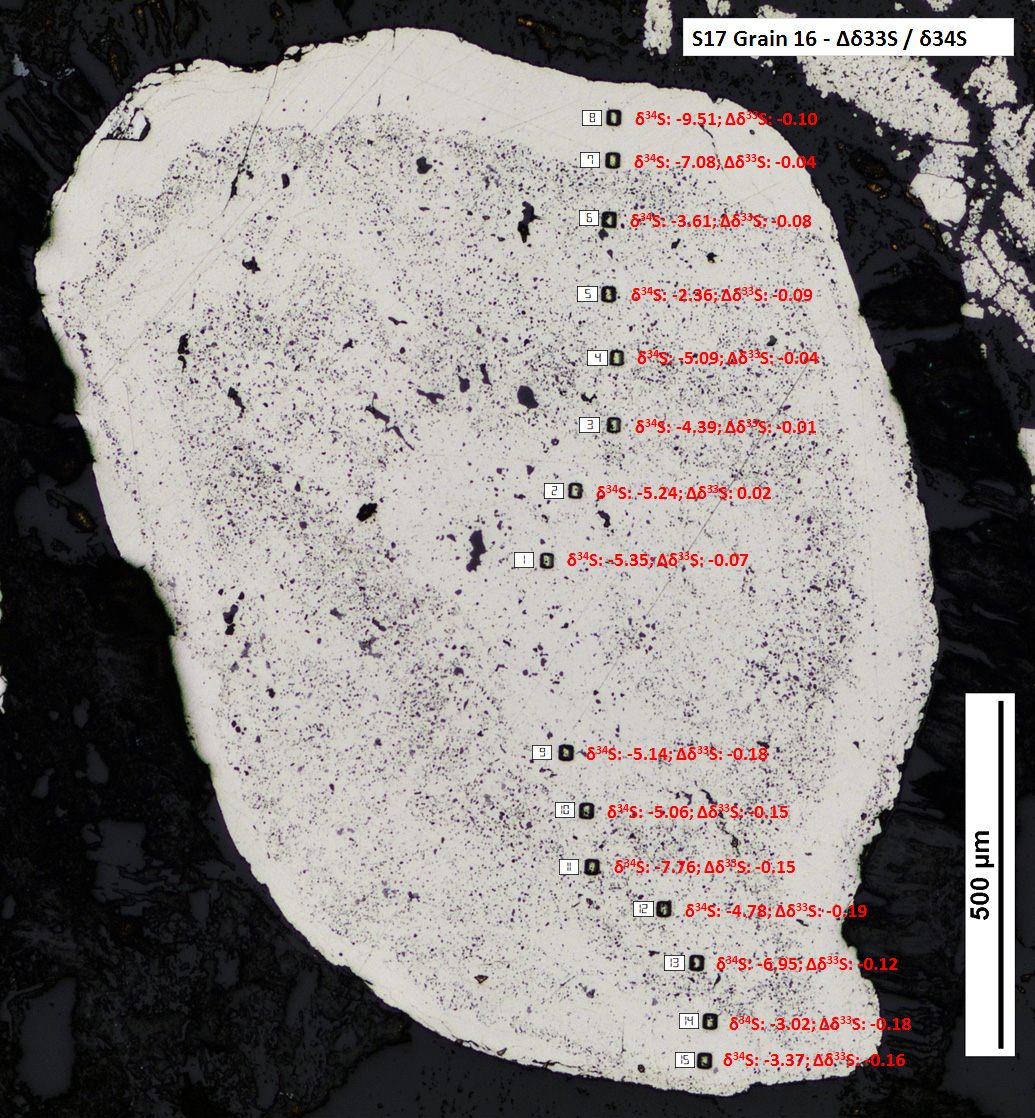
Scanning electron microscope image of a Neoarchean ‘buckshot pyrite’ grain from the 2.76 Ga Beatons Creek deposit, Pilbara, Western Australia. Grain shows textural and sulfur isotopic zonation, indicative of microbial precipitation from a water source with varying sulfate availability, probably a seasonally fluctuating stream. Image courtesy of Chris Guldbrandsen, UNSW.
2016 REPORT
In 2016, we were engaged in a wide range of research activities, including the habitat of the earliest evidence for life on Earth, the adaptation of life across the Great Oxygenation Event, and global tectonics. Additional studies focused on the origin of boron in the newly discovered sinter deposits of the 3.5 Ga Dresser Formation, Western Australia, and the origin and variability of ‘buckshot pyrite’ grains in a Neoarchean sedimentary-hosted gold deposit from the Pilbara region. Investigators participated in research activities in Australia, China, India, Japan and New Zealand, studied Martian meteorites, and helped guide NASA in their decision on where to land their Mars2020 rover. The UWA component focused on two main themes:
1) new constraints on the scale and rate of sulfur cycling in Proterozoic orogens and
2) new insights into the role of sulfides in the fractionation and concentration of chalcophile and siderophile elements in Martian igneous systems.
The presence of mass-independent fractionated sulfur in the Proterozoic granitoid rock record has the potential to revolutionise our understanding of secular changes in the evolution of crust formation mechanisms through time.
The discovery of the first platinum group mineral in a Martian meteorite provides new constraints on the redox state and metal budget of the Martian mantle.
FP4 research included colleagues from Australia, Europe, Japan and the USA. Fieldwork was conducted in Australia’s Pilbara, Hamersley and Ashburton regions, in the Archean Barberton Greenstone Belt of South Africa, in the Ladakh region of northern India, and in the northern Cape Province of South Africa.
Collaborative fieldwork activities included Dr Mark van Zuilen of the Institute de Physique du Globe de Paris (IPGP), and Prof Carsten Münker of the University of Cologne, Germany.
The Astrobiology Australasia 2016 meeting (Perth, 120 participants) was followed by a fieldtrip (25 participants) to see the ancient life of the Pilbara. CI Van Kranendonk also led a fieldtrip for a group of 50 German researchers across the southern Barberton Greenstone Belt.
FP4 participants attended the NASA Mars Biosignatures workshop in Lake Tahoe, NV, and the 35th International Geological Congress in Cape Town, South Africa. Visiting scholars Professor Clark Johnson (U. Wisconsin at Madison) and Dr Michelle Gehringer spent time at UNSW. Filming roles on ABC TV’s “The Living Universe” and December Media’s IMAX 3-D documentary “Earth Story” feature CI Van Kranendonk and UNSW PhD student Tara Djokic.
See Research highlights Astrobiology ‘Down under’: Visualising early life on Earth, Ancient boron-rich, Himalayan cauldron - the soup for early life?, An increase in the complexity of life across Earth’s Great Oxygenation Event.
Published outputs for 2016
CCFS Publications: #630, 639, 644, 657, 660, 682, 683, 686, 697, 699, 791, 797, 811, 813, 829, 837, 874, 847
16 Conference Abstracts

5. AUSTRALIA’S PROTEROZOIC RECORD IN A GLOBAL CONTEXT
Themes 2 and 3, Earth’s Evolution and Earth Today, contributing to understanding Earth’s Architecture.
AIMS
Earth’s history is considered to have been dominated by cycles of supercontinent formation and breakup. This program tests this hypothesis and its relevance to Australia’s geological evolution, assessing Australia’s positions during the supercontinent cycles by examining the paleomagnetic, petrological and detrital provenance record of the Australian and adjacent continents.
By studying primarily Australian rocks and comparing the results with global analogues, we aim to extend our knowledge about supercontinent cycles and the evolution of the Australian continent to the Paleoproterozoic or even further back in time. Such knowledge is fundamental for understanding the first-order fluid cycles that controlled the formation and redistribution of Earth resources, and the establishment of a 4D global geodynamic model covered in other Flagship Programs.
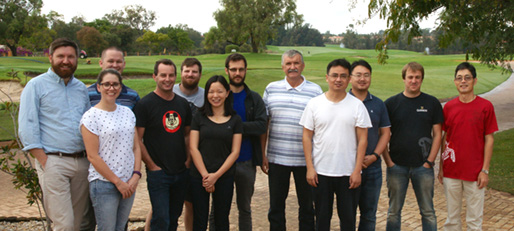
Members from Flagship Program 5.
2016 REPORT
In situ SHRIMP U-Pb dating of mafic dyke samples collected from SW Yilgarn during 2015 and 2016 was conducted. TIMS U-Pb analysis was undertaken in collaboration with UWA and Lund University (Sweden), confirming the presence of three previously unstudied dyke suites in SW Yilgarn Craton. Geochemical analyses were carried out for selected Yilgarn and Bunger Hills (Antarctica) dyke samples. Two additional paleomagnetic sampling trips were carried out on the Yilgarn dykes, and we are now trying to generate three new, high-quality paleomagnetic poles for Precambrian Yilgarn.
One sampling trip to the Gawler Craton targeting the Gawler Range Volcanics and the Gairdner Dolerites was conducted. Samples from 30 sites were collected and will be analysed by PhD student Yebo Liu in 2017. Pilot paleomagnetic sampling was also carried out on South Australia’s Truro Volcanics (~526 Ma) and the Gairdner Dykes (~827 Ma) in a Broken Hill Mine.
Detailed basin studies have been conducted on the Ediacaran- Silurian of South China, especially on the Cathaysia and southeastern Yangtze side. Field sampling and sedimentary section logging continued, and most provenance analytical work has been completed through collaborations. Two new papers reported our results on South China’s basin record during its collision with northern Gondwana (#710), and on Hainan Island’s record of the supercontinents Nuna and Rodinia (#883), were published. Pilot provenance studies were also conducted on the Cambrian and Devonian sedimentary rocks in the Ord basin, Kimberley; the results will be used for testing Australia’s connections to Asian continents during the Paleozoic.
A new key paleomagnetic pole and a 1975 Ma paleogeographic reconstruction of Fennoscandia were published (#882). New analysis of geological time series using a novel approach with sample weights proportional to continental surface areas established a strong correlation between the detrital-zircon and LIP age spectra (#840). We also analysed the accretional/ collisional orogens and passive margins of the ‘Iapetian’ parts of Rodinia during its evolution with implications for models of supercontinent cycles (#815, 888), and discovered the LIP barcode and paleomagnetic correlation of the Siberian, Congo, São Francisco and North China cratons, leading to a new model for their paleopositions in Nuna (#628). We also reported the first Ordovician paleomagnetic poles for the New Siberian Islands (Arctica) (#648).
IGCP 648, co-led by CCFS CI Li, is progressing well, including the publication of the CCFS-sponsored Geological Society of London Special Publication 424, and the compilation of global paleomagnetic and geological databases. For more achievements of IGCP 648 see http://geodynamics.curtin.edu. au/igcp-648/.
See Research highlights Earth’s magnetic switch activated in the deepest mantle and The giant sudoku of early Earth - a new solution?
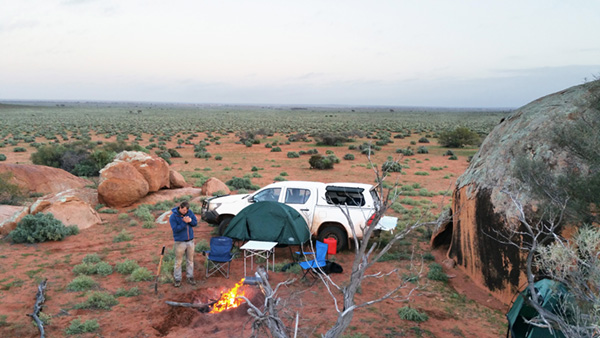
Uwe Kirsher camped within the Hiltaba Suite granites as part of a Paleomagnetic sampling campaign in the Gawler Ranges.
Published outputs for 2016
CCFS Publications: #642, 648, 664, 687, 709, 710, 723, 789, 790, 792, 798, 802, 804, 814, 815, 840, 869, 882, 883, 888, 891, 892, 893, 894, 897, 898
19 Conference Abstracts

6. FLUID REGIMES AND THE COMPOSITION OF EARLY EARTH
Themes 1 and 3, Early Earth and Earth Today, contributing to understanding Earth’s Architecture and Fluid Fluxes.
AIMS
Zircon crystals are currently the only material that records events in the first 500 million years of Earth’s history, since no rocks have survived from this period and no other minerals have been established as Hadean in age. There is growing evidence from the study of these zircon crystals that the Earth stabilised rapidly after accretion and that both solid rock and liquid water were present within 150 million years of its formation. In this program, the geochemical signatures of zircon crystals from all known Hadean and early Archean localities will be utilised, together with geochemistry of the oldest known rocks and the application of geophysical and geochemical modelling, to establish how the first crust formed, why it was destroyed, and the role fluids played in this process. The changes that took place throughout the Archean will also be evaluated as crustal processes evolved and plate tectonics became the dominant regime. A key component is determining the interaction between the mantle and the evolving crust. In addition, work undertaken on Martian meteorites and lunar samples will provide further constraints on the early history of the Solar System, especially the role played by fluids.
2016 REPORT
A major new initiative commenced on the Jack Hills detrital zircon suite from NW Australia with the aim of characterising the most pristine portions of the grains. Although there is a huge amount of published data on such crystals, it remains unclear what the true age spectra of the grains and the nature of their isotopic signature are. Solving these problems will place precise constraints on the earliest crust. Former CCFS PhD student Dr Rongfeng Ge was appointed to investigate these issues.
The isotopic study of another former PhD student, Dr Qian Wang, which includes over 6,000 U-Pb zircon analyses from her traverse through the entire Jack Hills belt, has been prepared for publication. Work on the identification of CO2 inclusions in Jack Hills’ zircons, in conjunction with German colleagues, is currently in revision.
Work continued on zircons obtained from the ancient gneisses of Labrador. SHRIMP and CAMECA 1280 data have been compiled and several areas targeted for further investigation in 2017. The Nd study on TTG rocks from the Anshan area of the North China Craton, with ages between 3.8-3.0 Ga, has been completed.
There are no systematic variations in 142Nd with age, but several rocks do show positive Nd anomalies. Also in China, work continued in the Kuruktag area of the northern Tarim Craton. Here, a newly-identified tonalite unit records an age of 3.7 Ga making it one of the oldest rock units in China. Additional zircon U-Pb and Lu-Hf analyses were undertaken on samples from Aker Peaks in Kemp Land, Antarctica, to better characterise their age and provenance. The metallic lead nanospheres in Napier Complex zircons were further characterised using NanoSIMS and an atom probe study will commence in early 2017.
Precise dating of phosphates in breccias from the Apollo 14 landing site has revealed a 10-15 Ma difference in age, indicating two impact events; a similar feature is observed at the Apollo 17 site. Work continued developing a chronology of lunar events, with evidence for major mantle differentiation at 4370 Ma and a major basalt-producing event at 4330 Ma. Ion imaging studies have shown that all zircons < 4 μm in size have been reset by impacts at approximately 4.2 Ga. Evidence for major differentiation of the Martian mantle at 4.5 Ga has been revealed by studies of both shergottite and pyroxenite meteorites. Martian breccia sample NWA7533 has plagioclase with a very primitive Pb composition, making the host fragments the oldest known material in the solar system.
Published outputs for 2016
CCFS Publications: #703, 705, 960, 961
6 Conference Abstracts

7. PRECAMBRIAN ARCHITECTURE AND CRUSTAL EVOLUTION IN WA
Themes 1, 2 and 3, Early Earth, Earth’s Evolution and Earth Today, contributing to understanding Earth’s Architecture.
AIMS
Iron, Gold and Nickel deposits are of global economic significance, and the Neoarchean Yilgarn Craton and the Proterozoic orogens around its margins constitute one of Earth’s greatest mineral treasure troves. Whereas the Yilgarn Craton is one of the best-studied Archean cratons, its enormous size and limited outcrop are detrimental to a deep understanding of what controls the distribution of resources and which geodynamic processes were involved in the tectonic assembly of the Australian continent. This program combines geological, geochemical and geophysical techniques to propose a 3D structural model of the lithosphere of the Yilgarn Craton and its margins. The Yilgarn Craton is a highly complex piece of Archean crust with a long history extending from 4.4-2.6 Ga: amalgamation of terranes is thought to have occurred around 2.65 Ga. The program includes the Capricorn Orogen Passive Array (COPA), a passive source experiment that studies the structure of the deep crust and shallow lithosphere using earthquake seismology. The data from this experiment will be the main source for the local ambient noise inversion, the receiver function common convection point (CCP) stacking techniques, and possibly a body-wave tomography study. Given the fact that the passive source site coverage in Western Australia is sparse and that the available permanent sites in the region provide nearly 10 years of data at isolated locations, several techniques that focus on crust and upper mantle structure beneath single stations will also be applied. This approach has the potential to provide quick access to the crustal and lithospheric structure from these representative sites.

Figure 1. Successful deployment of a trial station for the Canning Basin project near Broome, WA.
2016 REPORT
Recent work by GSWA in the northwestern part of the craton has identified a long-lived, autochthonous history of crustal development there. There is a growing realisation that understanding how mineralised crustal provinces form requires structural and chemical information on the entire lithosphere. This is addressed in the CCFS-associated multi-disciplinary SIEF project “The Distal Footprints of Giant Ore Systems: UNCOVER Australia”, which involves collaborative research between CSIRO, UWA, Curtin and GSWA, and targets the Capricorn Orogen at the northern boundary of the Yilgarn Craton.
The Capricorn Orogen Passive-source Array (COPA) field deployment reached a critical phase in 2016. In June and July, the western half of the COPA stations were moved over to the eastern region. By the end of the year, over two thirds of the array coverage had been achieved. By November 2017 the rest of the orogen will have been covered and the array will have recorded sufficient data for processing. In 2016, the data collected from previous services were analysed with a focus on the seismic structure of the Capricorn orogen crust. Two sub- projects targeting the crust of the Glenburgh Terrane and its northern boundary were conducted and yielded very intriguing results. From the seismic perspective, the interpretation favours that in between the Archean Pilbara and Yilgarn cratons, the Glenburgh terrane represents a microcontinent with strong Archean heritage that was caught and deformed during the assembly of the Western Australian craton. The Capricorn orogen therefore also preserves a unique piece of crust that may have witnessed the transition of crust-formation processes from early Archean vertical tectonics to the modern-style subduction related plate tectonics. The results were presented at several international meetings (including keynote presentations) and are currently in preparation for publication.
See Research highlights Unveiling the early history of crust in Western Australia and An Archean microcontinent lurking in the Capricorn Orogen
Published outputs for 2016
CCFS Publication: #704
4 Conference Abstracts
WHOLE OF CENTRE TECHNOLOGY DEVELOPMENT

1. CAMECA ION MICROPROBE DEVELOPMENT: MAXIMISING QUALITY AND EFFICIENCY OF CCFS ACTIVITIES WITHIN THE UWA ION PROBE FACILITY
Themes 1, 2 and 3, Early Earth, Earth’s Evolution and Earth Today, contributing to understanding Earth’s Architecture and Fluid Fluxes.
AIMS
The Ion Probe Facility within the CMCA at UWA is one of the best-equipped Secondary Ion Mass Spectrometry (SIMS) labs in the world. It houses a CAMECA IMS 1280 large-radius ion microprobe, for the high-precision analysis of stable isotopes in minerals, and two CAMECA NanoSIMS 50s for imaging mass spectrometry at the sub-micron scale. This program provides a dedicated Research Associate to facilitate CCFS activities and lead the development of standards and analytical protocols at the CMCA. This greatly benefits CCFS by increasing the capacity of the Facility, enabling a higher degree of interaction and participation on research projects, facilitating standards and protocols development, and allowing greater synergy with other CCFS node facilities. For progress in 2016 and plans for 2017, please see Technology Development

2. FRONTIERS IN INTEGRATED LASER-SAMPLED TRACE ELEMENT AND ISOTOPIC GEOANALYSIS
Themes 1, 2 and 3, Early Earth, Earth’s Evolution and Earth Today, contributing to understanding Earth’s Architecture and Fluid Fluxes.
AIMS
The overall aim is to develop new analytical methods for in situ measurement of trace elements and isotope ratios to support and enable CCFS research programs and to provide new directions of research. Specific objectives include:
(1) combined trace element and isotope analysis - ‘split-stream’ analysis
(2) development of ‘non-traditional’ stable isotopes
(3) characterisation of reference materials for elemental and isotope ratio measurement
(4) development of data reduction software for combined trace element and isotope analysis
For progress in 2016 and plans for 2017, please see Technology Development

 ARC Centre of Excellence for Core to Crust Fluid Systems
ARC Centre of Excellence for Core to Crust Fluid Systems